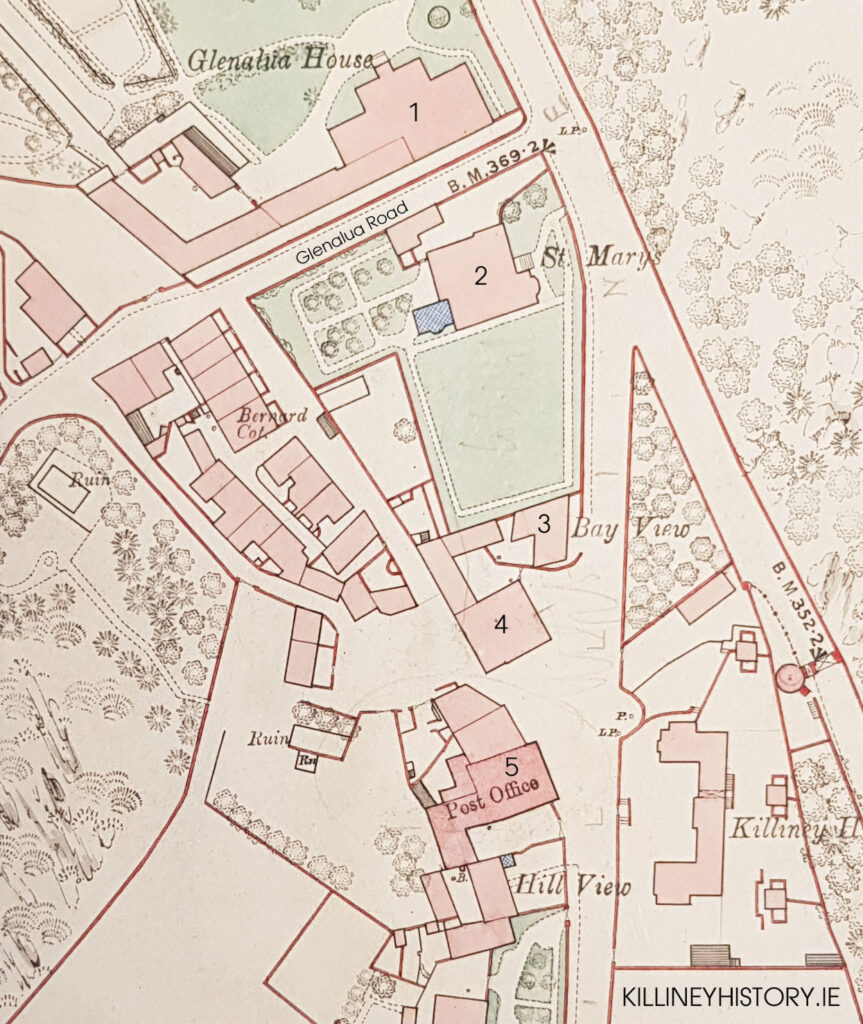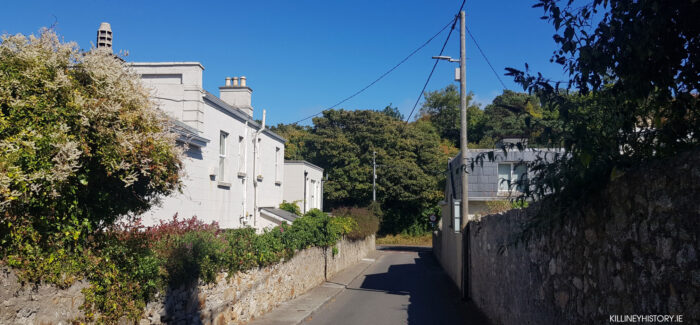Civil War attacks in Killiney 1922 by Hugh Comerford
Introduction
In the new Dail Eireann of the Irish Free State on 28 November 1922 the TD Darrell Figgis asked the Minister for Defence Richard Mulcahy about the series of outrages occurring in Dalkey (and Killiney) and why the persons responsible “who are well known in the locality have not been apprehended”.
The Minister for Defence referred to three serious incidents of Irregular (anti-treaty) activity including seizure of mails, and assured the deputy that the area is being “adequately looked after. The problem is that our troops do not get the local assistance that they would expect to get”.
Following the failure of the anti-treaty resistance in Dublin city and their subsequent defeat in West Wicklow, the approach of the Irregular forces including those of the local Dalkey, Killiney, Ballybrack men, members of the C Company, 2nd Battalion, South Dublin Brigade (under the command of Ardbrugh Road, Dalkey native Patrick Darcy) changed to guerrilla tactics. These basically meant disrupting any economic business or organisation that could allow the new Free State function, including attacks on the rail, postal, road, telephone communications and the seizure and destruction of enemy property.
This was in addition to the occupying of private property for billeting the anti-treaty troops and the requestioning, by force of arms, of supplies and materials from local businesses including tobacconists, Findlaters, grocery, hardware and clothing stores.
In the Dalkey, Killiney area the anti-treaty O/C Patrick Darcy was a 23-year-old veteran of the 1916 Rising, Stafford jail, the War of Independence and the Rath internment camp in Kildare and a fierce opponent of the new Free State government.
He had returned from West Wicklow in August 1922 to continue the guerrilla campaign in South Dublin and was based around the Dalkey and Killiney hills. He used to great advantage the terrain he had grown up with as cover, having trained with weapons as a 15-year-old with the Irish Volunteers in the Quarry in Dalkey. At that time, in August 1922 (the month Michael Collins was killed at Beal na mBlath), the main focus of the bitter Civil War had shifted to the South and West of Ireland, so the activities of the local Dalkey/Killiney anti-treaty forces were not typical of what was happening in Dublin and the East where the Free State forces were mainly in total control.

Photo courtesy of Cuala GAA/Michael Goodwin.
As the attacks on the postal, telephone, rail and roads systems increased, the Free State government decided to establish a post or barracks in the Killiney area using the house known as Glenalua House (now Mount Prospect) in the village of Killiney. In addition to acting as a fortified base, the post could be used for searches of Killiney Hill for arms, supplies and the capture of the anti-treaty IRA men that were causing all the havoc in the area.

However, for the anti-treaty forces under Patrick Darcy, the base in Glenalua House provided a prime target for direct armed attacks on the Free State troops manning it. From a military offence point of view, the wall and vegetation of Killiney Hill directly opposite the house gave excellent cover and opportunity to disappear when resistance got too hot.
The post in Glenalua House operated from about 1st September to 10th October 1922 under the command of a Capt. George O Hara who may have been selected for the job because he hailed from Railway Road in Dalkey.
The newspapers of the time give many descriptions of the attacks in the locality including those on the Glenalua House base.

One base used by the anti-treaty forces initially was Ashurst, a very substantial property, in Killiney, another was the telegraph tower on Dalkey Hill which was raided by the Free State forces on 4 August 1922. Previously the Masonic Hall in Dalkey and Killiney Castle had been taken over by them too. As their billets in vacant private houses were being raided by the Free State army, Darcy’s anti-treaty men had to rely on the many safe houses in the Killiney, Dalkey area for food and shelter, hence Mr. Figgis’s reference to those “who are well known in the locality “and Mr. Mulcahy’s response “with a little local assistance ……… would enable us to rid the area of them in a very short time “.
From the newspapers in August, September and October 1922 we find that the Free State post in Glenalua House was attacked at least four times in September and October 1922. Two of the attacks by the Patrick Darcy’s 2nd Batt Irregular force were serious gun-battles where rifles, handguns and grenades were used against the defending Free State garrison under Capt. George O Hara.

We do know in detail what damage was caused to both Glenalua House and neighbouring properties through the compensation files in the National Archives. Compensation was granted under the Damage to Property (Compensation) Act 1923.The largest compensation amount was paid to the proprietor of Glenalua House, Mr. John H. Waterhouse residing at Wyndham Road, Bray. He claimed a sum of £632-14-0 for damage done to Glenalua House by both National Troops occupying his house and more damage done on the house from Killiney Hill “by various attacks made on said National troops by bands of armed men during said period of occupation”.
More seriously Mr. Waterhouse also claimed £1,707-1-8 for damage by fire on two occasions on the 10th and 20th of October 1922 to Glenalua House “by unknown armed men”. The claim consisted of £707 for destruction of house and £1000 for loss of rent.
“The dwelling house Glenalua House had been occupied by National troops and after they left an attempt was made 10/10/1922 to burn said premises and this having failed a further attempt was made on 20/10/1922 by a body of men who set fire to the premises and damaged and destroyed them to the extent of £707-1-8 and resulting loss of rent”.

But it was not only Mr. Waterhouse who suffered during the attacks on Glenalua House in September of 1922. It was a Mrs. Mary Carey and her husband Joseph who probably bore the brunt of the gunfire and explosions during the two most intense attacks. Mrs Carey was a resident of St. Marys which is directly opposite Glenalua House. She describes in her compensation claim “For several nights prior to the 16th September 1922 the firing was intense but on the night of the 16th September the firing lasted for at least three hours and the damage to my said house was caused that night and the morning of the 17th,” slates, plastering, windows, woodwork, and a conservatory were all damaged at St. Marys. In addition, poor Mrs. Carey and family had to flee the house for six weeks at a cost of £20-0-0 for rent at alternative accommodation.
Another victim of the attacks in Killiney was a Mr. Charles J. Barre of the Victoria Hotel and Killiney Bar who on a different occasion suffered damage to his premises including “the plate glass window and other windows, also the shop door, ceiling and woodwork damaged in the house Killiney Bar result of an explosion of a hand grenade and rifle and revolver bullets”.
This damage occurred on the night of the 8th of October and the morning of the 9th October 1922 when “Mr. Barre was awoken from his sleep by an explosion and noise of a rifle or revolver and on proceeding to his shop he found damage done to his premises, He cannot say what party or parties committed the damage”, More damaging was the damage done when a telegraph pole was cut down and fell against his premises damaging it “to the extent of rendering it absolutely useless”.
We know from the Compensation files that the Free State forces left Glenalua House around the 10th October 1922 and probably relocated to a more secure base in the Dun Laoghaire Harbour Barracks. The anti-treaty force’s campaign continued with a raid the Dalkey DMP station on the 27 October 1922 when they took three automatic pistols and three rifles.
November 13 1922 saw what was one of the most tragic attacks on a Free State patrol on Ulverton Road Dalkey in which a soldier Corporal Samuel Webb (19) and an innocent civilian Mr. Henry Manning (43) were killed and a Private Michael Sharkey from Blackrock was seriously injured in both legs in an anti-treaty ambush involving 12 of Patrick Darcy’s men. Mr Manning who lived in the Pilot Cottages in Bulloch was returning from a visit to his brother-in-law Mr, H. Waterhouse of Claremont in Killiney when he was shot dead in crossfire during that ambush.
The evacuation of the temporary post of the Free State Army in Glenalua meant that there were no more static Free State military targets for the anti-treaty men of Patrick Darcy’s 2nd Batt., South Dublin Brigade.
The Free State army also had a presence in Dalkey Railway Station which was attacked with bombs, rifles and revolvers on the night of the 15 January 1923.
This group continued to mount occasional attacks on the government forces and continued its campaign of economic disruption. However, as the national momentum of the Civil War turned ever more vicious and in favour of the new Free State, the efforts of the small group in South County Dublin weakened and by March 1923 they consisted of only a handful of the most hardened anti treatyites. Many surrendered, many emigrated and many, including Patrick Darcy, went in to hiding until well after the ceasefire and into mid-1924.
The scars of the gun attacks and explosions in Killiney Village in September of 1922 lasted much longer than the occupation of the Free State forces in the damaged properties in Glenalua House, St. Mary’s, the Killiney Bar and others. Anyone approaching the Killiney village bus stop today after a pleasant and peaceful walk to the Obelisk might be hard pressed to imagine the gun battles and explosions that took place there one hundred years ago.
Sources:
Books: John Dorney, The Civil War in Dublin, (Dublin, Merrion Press 2017)
James Langton, The Forgotten Fallen, The Fallen of the Irish Civil War, Vol 1 (National Army Soldiers) , (Dublin , Kilmainham Tales Teo).
Newspapers: Freemans Journal, Irish Times, The Weekly Freeman,
Archives: Dail Debates online for 28/11/1922 .
Irish Military Archives Cathal Brugha Barracks: Military Service Pension Files of Patrick Leo Darcy. Irish Army Census Collection (12-13 November 1922. (Online Collections)
National Archives of Ireland, Bishop Street: Damage to Property (Compensation) Act 1923 files.
OPW/6/1/361 John H Waterhouse, Glenalua House.
OPW/6/1/362 Mary Carey, St. Marys,
OPW/671/363;FIN/COMP/2/6/50 C.J.Barre, Killiney Bar,
FIN/Comp/2/6/223 W.P.D’alton, Ardna Chree
About Hugh Comerford
Hugh is a former librarian resident in Killiney. His main interests are in Irish and local history and he has also worked and researched in genealogy.
